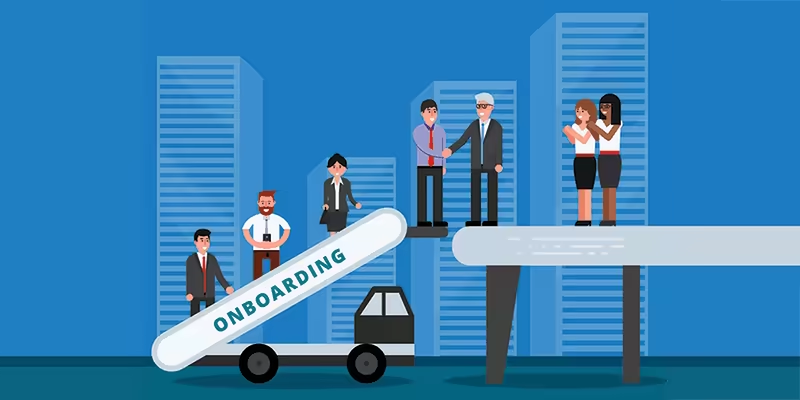Many times people use the terms employee onboarding and employee orientation interchangeably, but they mean different things. Both employee onboarding and employee orientation are needed for new employees that will have joined an organisation. Even though employee orientation is a part of the employee onboarding process, it still is necessary to take the new employees through the process. According to research by Glassdoor, organisations with a robust onboarding process improve new hire retention by 82% and productivity by over 70%. This is why you need both employee onboarding and employee orientation. Let us dive deeper into understanding the difference between employee onboarding and employee orientation and why you need both.
What is employee onboarding?
Employee onboarding is a step-by-step onboarding process process of purposefully and systematically transforming employees into top-performing employees. Organizations provide guidelines to new employees by introducing them to the organizational environment and culture to creating their first SMART strategic goals. It also includes the orientation process that takes them through the organizations mission, vision and values, completing the mandatory paperwork, etc. As a result, the employee onboarding process is more strategic, and it helps employees understand their primary duties and how they can accomplish them starting from their day-to-day tasks.
The development of the SMART strategic goals is usually done after an employee’s first 90 days, with several reviews done to check how the employee is connected within the organisation. According to a Sapling report, the average new hire onboarding experience consists of at least 54 activities. This means the new employee will be assigned at least three documents to sign, upload or acknowledge and at least 41 administrative tasks to complete. The new hire will be properly acclimated and incorporated into their new work thanks to the range of activities.
What is employee orientation?
Employee orientation is a shorter process than employee onboarding, and it is usually conducted on the first day or weeks of employment for new employees. It is done in a conference-style event bringing together several hires from the different departments across the organisation. Employee orientation is the process of introducing freshly hired employees to their new workplace. It gives employees the basic organisational information they need to feel prepared for their new team, department, and job at work.
The information is typically delivered to the new employees through presentations from different department heads or leaders in the organisation, including question and answer sessions. In addition, the heads of departments or leaders usually introduce themselves and give an overview of their roles within the organisation. The following list shows some of the information provided to the new employees during an employee orientation process:
- They are introduced to the organisations mission, vision, and values, usually done by the CEO or company leaders or long-tenured employees. These tell fascinating stories in their presentations that entice the new employees.
- They complete the mandatory paperwork, and the HR representative usually facilitates it. This includes completing personal details forms etc.
- The HR representatives also take the new employees through the benefits plan indicating how and when they can start using them
- They are taken through the critical policies within the organisation and any safety hazards they should be aware of. It includes a guided tour for demonstrations and full appreciations of the weight of the issues.
- An information technology representative can present how technology is used within the organisation, whether it is a BYOD type of an organisation or not, the passwords to the computer systems, and Wi-Fi.
Why you need both employee onboarding and employee orientation?
The differences between employee onboarding and employee orientation are mostly seen on:
- The focus areas of each process
- The duration of each process
- The setup
- The content covered in each process
- The outcome of each process
However, employee orientation is a part of employee onboarding that needs to be done to help the new employees understand the environments culture, enabling them to move with speed and start generating value for the organisation. The following table shows the differences between employee onboarding and employee orientation:
Both employee onboarding and employee orientation play an essential role, and they are not interchangeable. For example, you might explain your departments unspoken norms during onboarding, such as how the phone is answered by the third ring or that the assistants are in charge of answering the phones. However, you would then explain the companys overarching dedication to customer service during orientation.
Wrapping it up…
According to Digitate, employees who experience a hostile onboarding program are twice as likely to look for other opportunities, so it is essential to conduct these sessions. When utilised simultaneously, employee orientation and employee onboarding can help reduce employee stress and attrition by establishing role clarity, job satisfaction, and organisational commitment. The first step in encouraging high employee engagement is a well-executed onboarding process.
Kudzai Derera is a Consultant at Industrial Psychology Consultants (Pvt) Ltd, a management and human resources consulting firm.
LinkedIn: https://zw.linkedin.com/in/kudzaiderera
Phone: +263 242 481946-48/481950
Email: kudzai@ipcconsultants.com
Main Website: www.ipcconsultants.com

